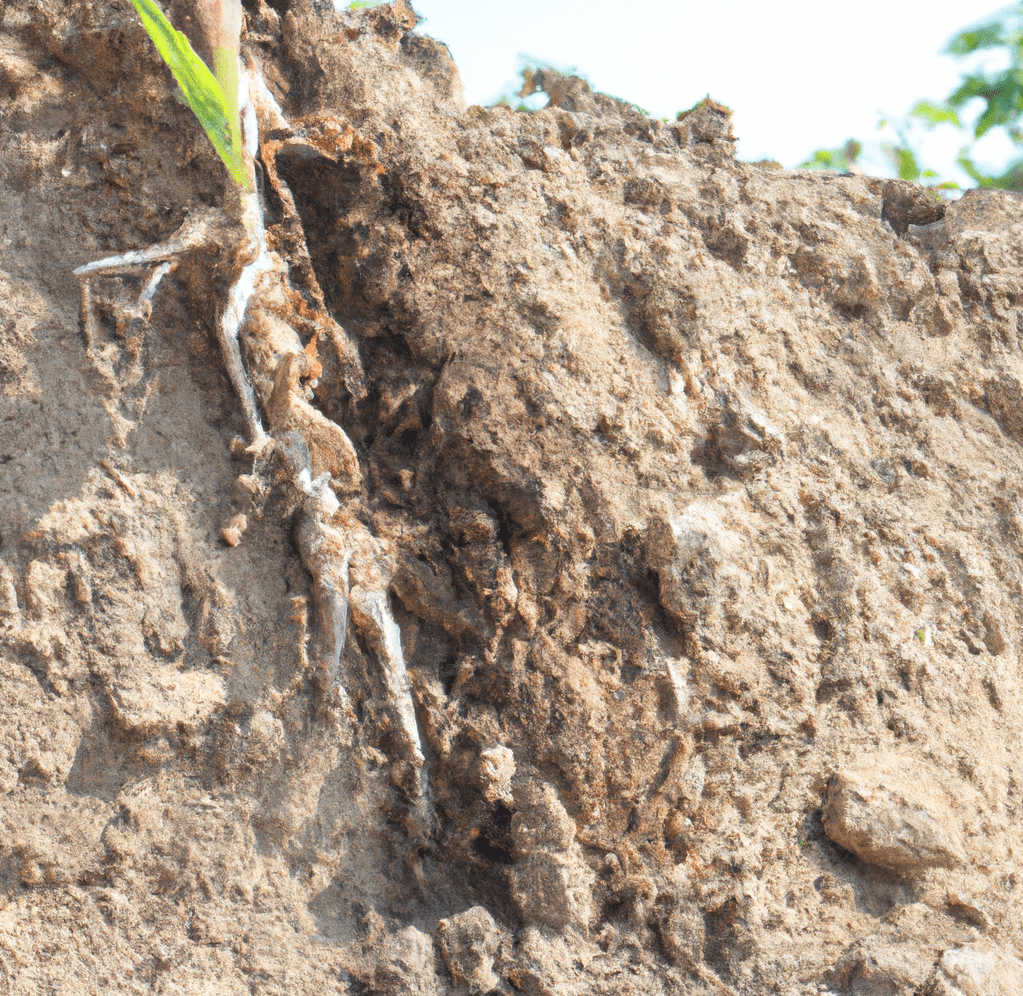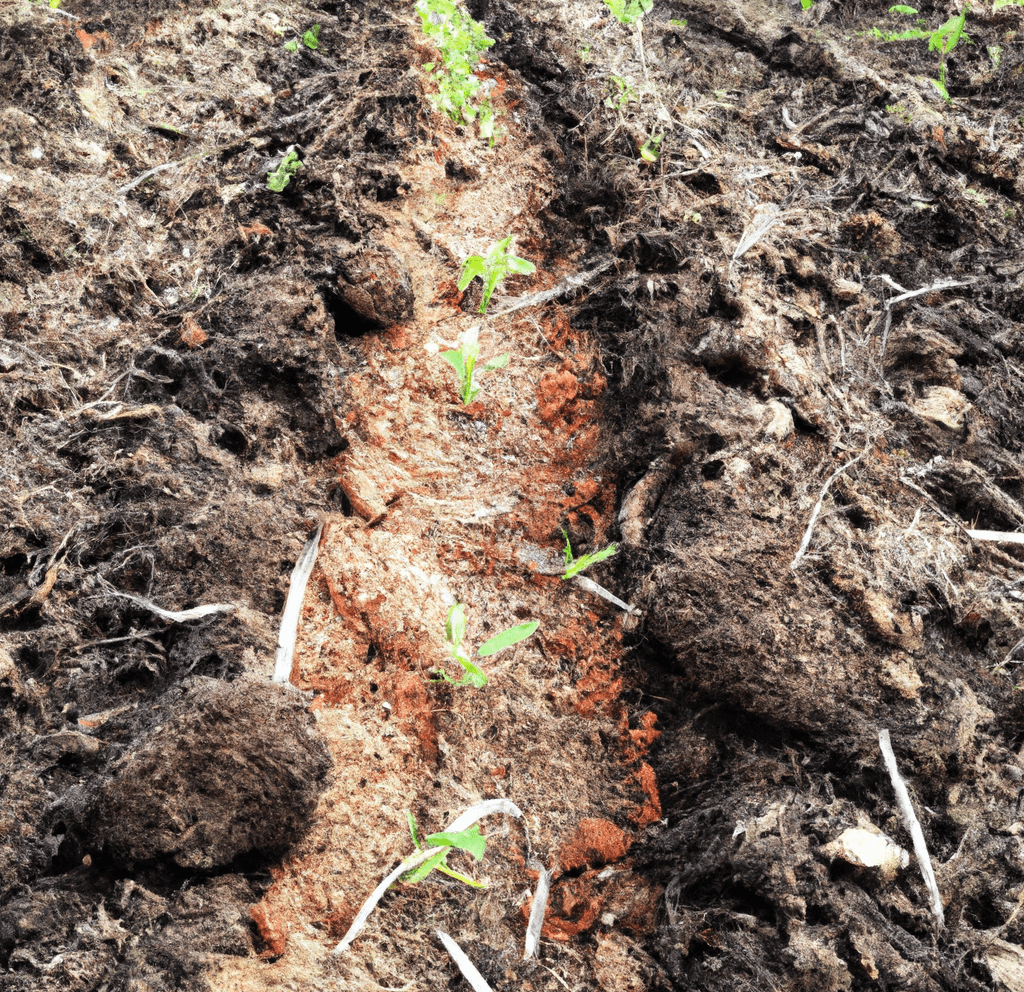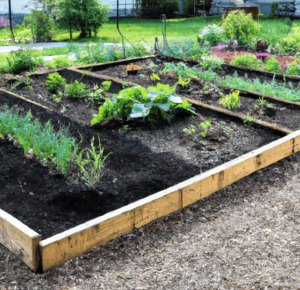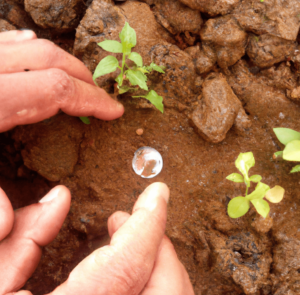The role of soil fertility in plant growth is to ensure development and provide plants with the necessary foundation they need to survive. An abundance of organic matter and a balanced supply of nutrients like potassium, phosphorus, and nitrogen characterize healthy soil. These circumstances give plants the optimum setting for growth, enabling them to attain their maximum potential and yield a lot of product. Without the vital nutrients that rich soil provides, plants struggle to form sturdy roots, leaves, and stems, which results in slower development and lower yields. Both farmers and gardeners can maintain soil fertility by using fertilizers, as well as natural practices like crop rotation and the utilization of organic matter. Synthetic fertilizers have the potential to increase yields, but they must be used properly to protect the ecosystem and the fertility of the soil.

Nutrients and Their Role in Plant Growth
It’s important to learn about the role of soil fertility in plant growth in order to help them to develop and flourish. The success of crop production is significantly influenced by the presence of these nutrients in the soil. These nutrients are essential for maintaining healthy soil, increasing agricultural output, and managing crops as a whole.
Plants must take up specific necessary nutrients from the soil, such as nitrogen (N), phosphorous (P), and potassium (K), collectively referred to as NPK, in order to sustain optimal development and health. To provide plants with the essential nutrients they need, chemicals and natural fertilizers are frequently employed.
However, not all fertilizers are created equal, so it’s critical to select the appropriate one for the type of plant, stage of growth, and soil conditions. For instance, phosphorus-rich fertilizers are better for boosting root growth and blooming while nitrogen-rich fertilizers are best for promoting leaf growth. Plants also need other micronutrients like iron, magnesium, and sulfur in addition to NPK.
For sustaining ideal plant development and health, proper soil management is also essential. This entails monitoring the soil’s pH, nutrient content, and organic matter on a regular basis and modifying the soil’s properties as needed. By doing so, you can ensure that the soil is nutritious and that the plants have access to the nutrients they need to thrive healthily.
Macronutrients (Nitrogen, Phosphorus, and Potassium)
Macronutrients, such as nitrogen (N), phosphorus (P), and potassium (K), are critical for the growth of plants and are also important for managing soil and increasing agricultural production. As you learn more about the role of fertility in plant growth, you’ll hear about these macronutrients referred to as NPK-make up the majority of fertilizers used in farming.
- For sustaining healthy plants and boosting agricultural productivity, adequate macronutrient management in the soil is essential. Nitrogen is an essential part of chlorophyll and is necessary for photosynthesis, leaf development, and plant vigor.
- Phosphorus is necessary for the growth of seeds and roots as well as for the transport of energy within plants.
- Potassium builds cell membranes, controls water flow, and improves disease resistance. In order to enrich the soil and provide plants with the nutrients they require to flourish, fertilizers with the proper NPK balance can be applied.
However, it’s crucial to apply fertilizers properly, as improper application can result in soil imbalances and environmental issues.
Micronutrients (Iron, Zinc, and Copper)
Along with macronutrients like phosphorus and nitrogen, micronutrients are critical for plant growth and development. As you learn more information on the role of soil fertility in plant growth, you’ll learn that these micronutrients are needed in lesser amounts than macronutrients, yet they are essential to many different plant activities. Three essential micronutrients for plant growth are iron, zinc, and copper.
Managing soil nutrients is a crucial part of making sure that plants get the essential micronutrients. Although soil frequently contains iron, zinc, and copper, the availability of these elements to plants may be constrained by elements including soil pH, organic matter concentration, and other competing ions.
These micronutrients can be made available to plants easily by using good soil management practices such as fertilization, pH adjustment, and organic matter addition. Iron, zinc, or copper deficiencies can cause stunted development, chlorosis (leaf yellowing), and other symptoms. However, too many of these micronutrients can also be detrimental to plants, so it’s critical to properly control soil nutrients to make sure that plants get the right dosages of these vital components.
Soil pH and Its Effect on Nutrient Availability
The availability of nutrients for plants and, consequently, agricultural output, is significantly influenced by soil pH. The pH scale has a range of 0 to 14, with 7.0 representing neutrality, values below 7.0 indicating acidity, and values above 7.0 indicating alkalinity.
The solubility and availability of vital plant nutrients like nitrogen, phosphorus, and potassium are influenced by the pH of the soil. Most crops are thought to grow best on soil that has a pH between 6.0 and 7.0 because it allows for the best availability of vital nutrients. A soil pH that is out of the ideal range might restrict plant nutrient uptake and lower agricultural yield. For instance, acidic soil with a pH below 6.0 might limit the availability of certain nutrients like manganese, zinc, and copper, whereas alkaline soil with a pH above 7.0 can limit the availability of minerals like phosphorus and iron.
Farmers can use fertilizers to increase the soil’s nutritional content and bring the pH level within the ideal range in order to solve these problems and take advantage of the role of soil fertility in plant growth. It’s crucial to remember, too, that putting fertilizers in the ground can also change its pH and cause an imbalance in the nutrients it contains. Therefore, to maintain ideal soil fertility and promote strong plant growth, it is crucial to frequently evaluate the pH and nutrient levels of the soil and alter fertilization procedures accordingly.
Soil Organic Matter
The health and fertility of the soil are significantly influenced by soil organic matter (SOM). It is a crucial component of healthy soil and consists of the decomposing remains of microbes, plants, and animals. SOM is made up of organic material that has degraded and acts as a reservoir for nutrients necessary for plant development. For optimum fertilizer supply and soil health, SOM management must be done properly.
SOM boosts soil fertility and nutrient availability strengthens soil structure and water-holding capacity and increases the soil’s capability to support plant development. As a sponge, the organic matter holds and releases nutrients to the plants as required. Additionally, it aids in controlling soil pH, fostering the development of bacteria that aid in the breakdown of organic matter and the release of nutrients that are available to plants.
Soil management techniques like cover crops, reduced tillage, and the use of organic amendments are successful tactics to keep or raise SOM levels. Planting crops to protect the soil and replenish it with organic matter or cover cropping has many benefits. Reduced tillage techniques lessen soil disturbance, which encourages the accumulation of SOM levels. To enhance the amount of organic matter in the soil and provide plants with more nutrients, organic amendments can be added, such as compost or manure.

Importance of Organic Matter in Soil Fertility
The role of soil fertility in plant growth is creating a foundation for life. Organic matter is one of the main factors that affect soil fertility. The decayed remains of plants and animals, known as organic matter, are what give soil its essential nutrients, strengthen its structure, and hold onto water.
For long-term soil fertility and productivity, proper management of soil organic matter is crucial. Essential nutrients including nitrogen, phosphorous, and potassium are provided by organic matter and are necessary for plant growth.
Additionally, it improves the soil’s capacity to store water, enabling plants to access it during dry spells. This is particularly significant in areas with scarce water supplies where managing soil fertility is essential for agricultural production. Also, organic matter strengthens the soil’s physical composition, allowing plant roots to more easily access vital nutrients and water.
How to Increase Organic Matter in Soil
The role of soil fertility in plant growth is vital and increasing the amount of organic matter in the soil is one method for enhancing soil fertility and encouraging plant development.
Organic matter is an important part of the soil that gives plants the nutrients they need, enhances the structure and water retention of the soil, and encourages the development of healthy soil microbes. Here are several strategies for boosting soil organic matter:
- Composting: Adding organic matter to soil through composting is a quick and efficient process. Organic waste, including kitchen scraps and yard trash, is combined with other substances, such as leaves and straw, to create compost. After some time, the combination begins to degrade, yielding a fertile soil amendment that is rich in nutrients. For instance, there are various advantages of using worm composting in your garden.
- Legumes: These are a good example of a cover crop that may be utilized to increase soil fertility by incorporating organic matter. By fixing nitrogen from the air and transforming it into a form that plants can utilize, cover crops enrich the soil with vital nutrients.
- Manure: Adding manure to the soil is a successful method of introducing organic matter. Manure from animals and birds is nutrient-rich and adds organic matter to the soil, enhancing its fertility and structure.
- Mulching: Mulching is the process of covering the soil with an organic layer, such as leaves, straw, or grass clippings. The mulch gradually decomposes, supplying the soil with organic matter and enhancing soil structure.
Including these techniques in your routine for managing your soil can assist increase soil fertility and encourage strong plant development. To achieve optimal plant growth, it may be necessary to address additional parameters, such as soil pH, since soil fertility is a complex system.
Soil Structure and Water Retention
Agricultural production and soil fertility can be significantly impacted by soil structure and water retention, both of which are essential elements of good soil. A mixture of different-sized particles, organic matter, and enough pore space that permits appropriate water and air circulation are the characteristics of a well-structured soil. This kind of soil structure benefits the soil’s general health by enhancing its capacity to hold onto moisture and nutrients and encouraging the development of strong plants.
Utilizing cover crops, conserving tillage, and composting are examples of good soil management techniques that can enhance soil structure and water retention and better the role of soil fertility in plant growth. These methods aid in raising the amount of organic matter in the soil, which can enhance soil structure and water-holding ability.
For the purpose of preserving soil fertility and fostering healthy plant growth, adequate water retention is crucial. Poor soil structure can cause water to run away quickly, making it difficult for plant roots to get the water and nutrients they require. On the other hand, the soil has a better capacity to store water and nutrients when soil structure is good and water retention is high, making them more readily available to plant roots.
How Soil Structure Affects Water Retention and Nutrient Availability
The role of soil fertility in plant growth depends on water retention and nutrient availability. The organization of soil particles and organic matter into discernible units known as peds is referred to as a soil’s structure. The soil’s capacity to contain water, air, and plant nutrients-all essential for strong plant growth-is determined by the peds. By increasing the quantity of organic matter in the soil, carbon-neutral measures like the use of cover crops can aid in improving soil structure.
In order to build sturdy peds and a more porous soil structure, organic matter acts as a glue to bind soil particles together. Water can now more easily permeate the soil and get to the roots of plants, where it can be utilized for upkeep and growth. In addition, the organic matter in the soil serves as a reservoir for plant nutrients, facilitating easier access for plants.
On the other hand, techniques like tillage that weaken soil structure can reduce water retention and nutrient availability. Tillage can compact the soil, which can impair water infiltration and porosity. Additionally, it may alter the peds’ structural integrity, which may have an adverse effect on water retention and nutrient availability. Water retention and nutrient availability, which are crucial elements for plant growth and maintenance, are determined in large part by soil structure. While techniques that improve soil structure, including the planting of cover crops, can benefit, techniques that damage soil structure can reduce water retention and nutrient availability.
How to Improve Soil Structure
When you’re learning about the role of soil fertility in plant growth, healthy soil has the proper proportions of nutrients, water, and air, all of which are necessary for plants to flourish. Increased agricultural output, better nutrient retention, and enhanced soil fertility can all result from improving soil structure. Here are some suggestions for enhancing soil structure:
- Add organic matter: By enhancing the soil’s ability to store water and nutrients, adding organic matter such as compost or manure can help the soil’s structure.
- Reduce tillage: Reducing or eliminating tillage is a critical strategy for enhancing soil structure because excessive tillage can destroy it.
- Establish cover crops: By enhancing soil health and contributing organic matter, cover crops aid in the development of soil structure. They also aid in preserving soil moisture and reducing erosion.
- Use mulch: By preventing soil compaction and retaining moisture, adding a layer of mulch to the soil’s surface can help to improve soil structure.
- Use crop rotation: Crop rotation can maintain soil structure by preventing the accumulation of plant pathogens and illnesses that are transmitted through the soil.
By taking these actions, you can enhance your soil’s fertility and general health, which will raise agricultural productivity and promote healthier plant growth.
Managing Soil Fertility
The role of soil fertility in plant growth is central to crop output. Maintaining soil fertility is crucial because crops’ growth and development are influenced by the nutrient content of the soil. Adding fertilizers, which are chemical mixtures that provide vital plant nutrients, is one of the most efficient ways to achieve this. However, overusing fertilizers can cause soil degradation, which over time can lower agricultural yield.
Adopting a carbon-neutral strategy is crucial for maintaining soil fertility and agricultural productivity. In order to achieve this, synthetic fertilizers must be used less frequently while organic fertilizers like compost, animal dung, and biochar are encouraged. Organic fertilizers help to improve soil structure and water-holding capacity in addition to supplying the soil with vital nutrients.
Increasing agricultural output and ensuring sustainable agriculture depends on maintaining soil fertility. In the long run, maintaining soil fertility and boosting the use of organic fertilizers can increase agricultural productivity. These actions include adopting a carbon-neutral strategy, lowering the use of synthetic fertilizers, and promoting their usage.
Testing Soil Fertility
The role of soil fertility in plant growth is vital and the amounts of various plant nutrients, such as nitrogen, phosphorus, and potassium, as well as secondary nutrients like calcium and magnesium, can be used to test the soil’s fertility. Additionally, testing for soil fertility can evaluate the soil’s acidity, which is crucial for figuring out the availability of plant nutrients.
An activity or process is said to be carbon neutral if it does not cause a net increase in the amount of carbon dioxide (CO2) in the atmosphere. By balancing the quantity of carbon in the soil, carbon-neutral farming practices seek to maintain or enhance soil fertility. This is crucial because healthy soil functions as a carbon sink, soaking up carbon dioxide from the air and storing it as organic matter. Farmers and gardeners can make sure that their methods are fostering carbon neutrality and that the soil is healthy and capable of supporting plant development by assessing soil fertility.
Fertility Management Techniques (Fertilization, Crop Rotation, and Cover Cropping)
Effective fertility management methods can raise agricultural output. The right application of fertilizers to supply crops with the nutrients they need for growth is one of fertility management’s most crucial components. However, using fertilizers can also have unfavorable effects, such as soil damage and an increase in greenhouse gas emissions, which is why the role of soil fertility in plant growth is important:
- Compost is an example of an organic fertilizer. Synthetic fertilizers include chemical fertilizers. Modern agriculture frequently employs synthetic fertilizers, but due to their detrimental effects on the environment and human health, organic fertilizers are becoming more and more popular as an alternative.
- Another crucial fertility management strategy is crop rotation. It entails cultivating several crops on a plot of land in a particular order in order to enhance the fertility and health of the soil. For instance, cultivating cereal crops like wheat and corn can assist to increase soil organic matter while cultivating legume crops like beans and lentils can supply nitrogen to the soil.
- Another method for enhancing the fertility and health of the soil is to plant cover crops. In order to reduce soil erosion, enhance soil structure, and increase carbon sequestration, which helps make agriculture more carbon neutral, cover crops are sown in between the main crops. In addition to helping to control weeds, fix nitrogen, and offer homes for helpful insects, cover crops are a crucial component of sustainable agriculture.
For increasing agricultural output and minimizing the detrimental effects of modern agriculture on the environment and human health, fertility management strategies including fertilization, crop rotation, and cover crops are crucial. Farmers may grow crops with great yields while simultaneously keeping healthy soil and preserving the environment by applying these methods sustainably.
Bottom Line: The Role of Soil Fertility in Plant Growth
You need to learn about the role of soil fertility in plant growth to ensure proper development. The roots may anchor on it and take up the water and nutrients they need to survive and thrive. The availability of vital nutrients in the soil, or soil fertility, has a big impact on crop success and overall agricultural production.
Effective soil fertility management is essential for encouraging healthy plant growth. Numerous strategies, such as the use of fertilizers, crop rotation, and other agricultural methods, can be used to accomplish this.
The success of crops and the total productivity of agriculture depend on it. Fertility can be effectively managed by applying fertilizers and other techniques, which can assist guarantee robust and abundant crop yields. Additional sources, including academic research, governmental organizations, and agricultural extension services, can offer crucial knowledge and assistance to people trying to increase soil fertility.
FAQs on The Role of Soil Fertility in Plant Growth
What part does soil fertility play in plant development?
To ensure development and give plants the support they need to thrive, soil fertility plays a crucial role in plant growth. The ideal environment for growth and the highest possible yields are provided by healthy soil, which is defined by an abundance of organic matter and a balanced supply of nutrients like potassium, phosphorus, and nitrogen.
How can gardeners and farmers maintain the fertility of the soil?
Fertilizers can be used by farmers and gardeners to preserve the fertility of the soil, as can organic farming methods including crop rotation and the use of organic materials. Although they have the potential to boost yields, synthetic fertilizers must be utilized carefully to safeguard the ecosystem and soil fertility.
What nutrients are necessary for plant growth?
Nitrogen (N), phosphorous (P), and potassium (K), generally referred to as NPK, as well as other micronutrients like iron, magnesium, and sulfur, are essential for plant growth.
What are macronutrients and what function do they serve in plant growth?
Macronutrients like nitrogen (N), phosphorus (P), and potassium (K) are essential for soil management and plant growth. Phosphorus is required for seed and root growth and energy transport, nitrogen is essential for photosynthesis, leaf development, and plant vigor, and potassium is required for cell membrane construction, water movement, and disease resistance.
What are micronutrients and what function do they serve in plant growth?
Even though they are required in less amounts than macronutrients, micronutrients like iron, zinc, and copper are crucial for the growth and development of plants. Micronutrients can be made available to plants by good soil management techniques like fertilization, pH adjustment, and the addition of organic matter. To guarantee that plants receive the necessary amounts of soil nutrients, proper soil nutrient management is crucial.
How does soil pH impact the availability of nutrients?
The availability of nutrients for plants and agricultural output are strongly influenced by the pH of the soil. For the most effective availability of essential nutrients, most crops grow best in soil that has a pH between 6.0 and 7.0. An out-of-range soil pH can limit nutrient uptake and reduce yields. For example, an acidic soil can restrict the availability of minerals like manganese, zinc, and copper, while an alkaline soil might restrict the availability of minerals like phosphorus and iron.
Why does soil retain water the way it does?
Water retention and soil structure are crucial components of healthy soil that can affect soil fertility and agricultural output. Different-sized particles, organic matter, and enough pore space to for proper water and air movement make up a well-structured soil. By improving the soil’s ability to retain moisture and nutrients and encouraging robust plant growth, good soil structure is beneficial to the soil’s overall health.
What are some effective soil management methods to improve soil structure and water holding capacity?
Utilizing cover crops, minimizing tillage, and composting are good soil management practices to improve soil structure and water retention. These techniques enhance the soil’s structure and capacity to retain water while increasing the quantity of organic matter present in the soil.
Why is sufficient water absorption essential for maintaining soil fertility and promoting wholesome plant growth?
Because poor soil structure can cause water to drain away fast, making it difficult for plant roots to receive water and nutrients, adequate water retention is essential for maintaining soil fertility and promoting healthy plant growth. Water and minerals can be stored more easily in soil with good soil structure and high water retention, which makes them more accessible to plant roots.
How are nutrient availability and water retention impacted by soil structure?
Because the arrangement of soil particles and organic matter into peds impacts the soil’s ability to hold water, air, and plant nutrients, soil structure has an impact on water retention and nutrient availability. While practices that harm soil structure, such as tillage, can lower water retention and nutrient availability, improving soil structure through actions like planting cover crops can boost it.
What techniques can be used to enhance soil structure?
Adding organic matter, lowering tillage, growing cover crops, applying mulch, and adopting crop rotation are a few strategies for enhancing soil structure. These acts can improve soil fertility and encourage the growth of healthier plants.
How are soil nutrients assessed?
Various plant nutrients, including nitrogen, phosphorus, and potassium, as well as secondary elements like calcium and magnesium, are measured in the soil to determine its fertility. In order to estimate the availability of plant nutrients, soil fertility tests also assess the acidity of the soil.







